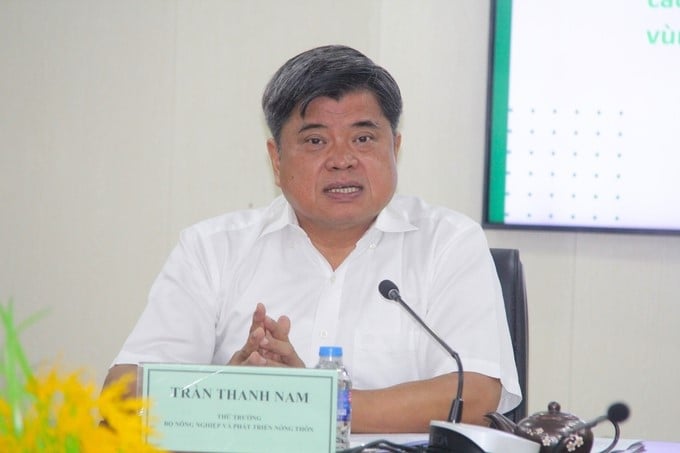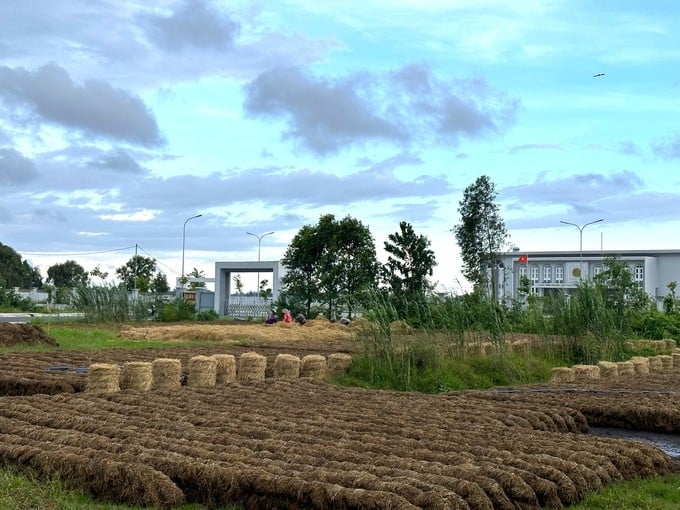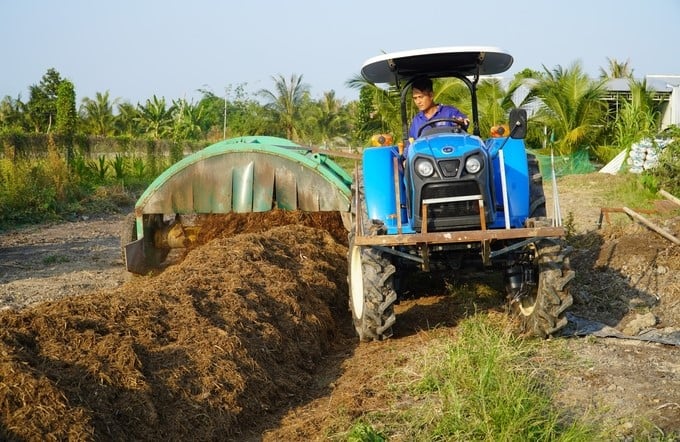November 23, 2025 | 04:11 GMT +7
November 23, 2025 | 04:11 GMT +7
Hotline: 0913.378.918
November 23, 2025 | 04:11 GMT +7
Hotline: 0913.378.918

Deputy Minister Tran Thanh Nam said that there are currently businesses using straw as a raw material to serve the industrial sector. Photo: Kim Anh.
On May 31, in Can Tho City, Deputy Minister of Agriculture and Rural Development Tran Thanh Nam chaired a conference to provide guidance on a number of contents related to the rights and responsibilities of organizations and units participating in the 1 million hectares of high-quality rice project.
According to the project content, when participating, cooperative members must commit not to burn or bury straw in flooded fields without solutions to limit greenhouse gas emissions. At the same time, cooperative members must collect straw out of the field according to Decision 145/QD-TT-CLT of the Department of Crop Production (Ministry of Agriculture and Rural Development - MARD). However, some delegates said that it is now very difficult for farmers to remove straw from the field.
Responding to this opinion, Mr. Le Thanh Tung, Deputy Director of the Department of Crop Production, said that moving straw out of the field is part of the farming process mentioned in the project. This method aims to reuse straw for other purposes and increase income for farmers.
According to Mr. Tung, there are currently many businesses and scientists who say they can decompose straw by spreading Trichoderma fungus or other products, but no one has been able to provide a report proving the results. Therefore, to reduce greenhouse gas emissions, straw must be removed from the field. Many localities consider this problem difficult, but it must be done.
To serve the project, the International Rice Research Institute (IRRI) and the Department of Crop Production coordinated to conduct a field investigation of 10,000 rice-growing households in the Mekong Delta. The result showed that the proportion of people able to remove straw from the field was 58% in the winter-spring crop; 32% in the summer-autumn crop; and 25% in the autumn-winter crop.
From the above result, Mr. Tung commented that in all three rice production crops, farmers moved straw out of the fields in all localities. Because straw has so much potential in the future, the removal of straw from the field will steadily increase.
On this issue, Deputy Minister Tran Thanh Nam emphasized: "Do not worry about the problem of straw not being taken out of the field." According to the Deputy Minister, currently, straw in the Mekong Delta is only used to make mushrooms and organic fertilizer. However, businesses have tended to use straw as a raw material for the industrial sector.
"There was a foreign business planning to build a factory in Ha Tinh to make steel from straw. When they heard about the project, they changed their plan and went back to Binh Duong to implement it. Because the Mekong Delta does not have enough industrial land for this business to operate on a scale of 200 hectares," said Deputy Minister Tran Thanh Nam.

Moving straw out of the field is part of the emission-reducing rice farming process mentioned in the 1 million hectares of high-quality rice project. Photo: Kim Anh.
MARD's leader said that the above-mentioned business needs about 1 million tons of straw per year to serve steelmaking. To ensure the supply of straw to meet the business's needs, the agricultural sector of localities must calculate in order to provide continuous supply to help investors operate.
According to the draft decision promulgating instructions for implementing criteria for selecting and participating in the 1 million hectares of high-quality rice project, outside organizations and units participating in the project will benefit according to the provisions of the law and at the same time receive support from relevant mechanisms and policies.
Regarding responsibility, the participating organizations and units must comply with Decision 1490 of the Government, the sustainable farming process, and the MRV plan (a tool to evaluate greenhouse gas emission reduction activities) issued by MARD and implement responsible value chain linkages.

Model of utilizing straw to make organic fertilizer at New Green Farm Cooperative, Can Tho City. Photo: Kim Anh.
International organizations participating in the project will benefit from Vietnam's regulations on emission reduction and the green economy. On the contrary, there is also an obligation to support resources as well as other related issues in the project.
To soon put the draft into implementation, Deputy Minister Tran Thanh Nam directed the Department of Economic Cooperation and Rural Development to coordinate with the Department of Crop Production to soon amend the draft according to comments from the local agricultural sector. By June 7, MARD will continue to receive comments from businesses, proceeding to official issuance.
Translated by Thu Huyen

(VAN) Results from the Sustainable Durian Model Project in Dak Lak have confirmed the critical role of Yara Viet Nam in transferring advanced nutritional solutions to farmers.

(VAN) In Tuyen Quang province, livestock farmers have introduced effective models and innovative practices that significantly strengthen African Swine Fever prevention and control efforts.

(VAN) This is the study conducted by IRRI and Can Tho University on the rice straw value chain in Mekong Delta showing an economic potential of more than 6.6 trillion VND/year.

(VAN) By participating in cooperative economics, many farmers in Tay Ninh have overcome hardship, mastered clean dragon fruit cultivation techniques.

(VAN) The crossbreeding program in the former Binh Dinh province (now part of Gia Lai) has shown signs of decline, and urgent measures are needed to revive it and sustain past achievements.

(VAN) The agricultural sector agreed on a roadmap to pilot the MRV protocol and expand low-emission rice production from the 2025-2026 winter-spring crop.

(VAN) Agricultural extension officers in Quang Ninh do more than transmit knowledge; they have become a steadfast support system for farmers on the path to sustainable agricultural development.